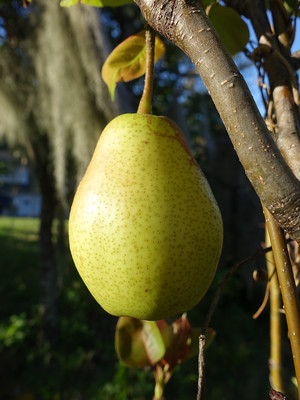
We all love our dogs, and we want them to not only enjoy their food but be nourished by it.
We never want to feed our dogs anything that could potentially cause them harm, so it’s always best to research food thoroughly before you consider giving it to your best buddy.
Today our topic is Asian pears, and whether or not you can or should give it to your dog to eat.
So without further ado let’s get right into it…
Can dogs eat Asian pears?
The short answer is yes, dogs can eat Asian pears in moderation.
You just want to make sure that you prepare the pears properly in order to make sure your dog gets the safest experience possible, and as long as you do that then Asian pears can make an excellent treat for your furry companion.
But if you’re anything like me then you don’t want the short answer, so let’s discuss some of the details.
What is an Asian pear?
If you’ve never heard of an Asian pear before then you’re probably wondering what exactly it is, and how it is different from a regular pear (we’ll get into some of those differences over the course of the article, don’t worry).
But back to the question at hand, an Asian pear is an apple-shaped fruit that is native to Japan and China but is also cultivated in Australia and New Zealand.
There are many varieties of the Asian pear, thousands to be exact.
Asian pears are known for their trademark crisp and juicy texture as well as their refreshing flavor.
All pears originate from ancestors in western China, but some of these pears were carried westward and modified.
One well known example of one of these pears in the Bartlett pear.
Other pears traveled eastward instead, and these pears started to become more apple-like in shape and crisper in texture when they reached Korea and Japan.
For a very long time this delicious fruit was only available to royalty and other wealthy people, but nowadays anyone can get their hands on Asian pears.
They’re arguably the most popular fruit in Asia, and are becoming better known all around the world currently.
Asian pear vs. pear. Which has more nutrition?
For the sake of our comparison in this section let’s say that we’re measuring the nutritional difference between the Asian pear and the Bartlett pear since the Bartlett pear is the pear that most of us think of when we imagine the “traditional” regular pear.
In this comparison the Asian pear would win as the most nutritious.
If we measure by 100 grams then we’d see that per 100g Asian pears have 33.33% more magnesium, 28.21% more protein, 43.75% more lipids, 16.13% more dietary fiber, 25% more leucine, 4.88% higher water content and just over one and half times more manganese, and 27.24% less sugars than Bartlett pears.
All of this combined means that although the Bartlett pear has its own set of benefits it is still less nutritious than the Asian pear.
How much Asian pear should I feed my dog?
Maybe by this point in our discussion you’re considering giving your pup one of these tasty treats, in which case you’ll want to know how much you can give it.
The answer not only applies to Asian pears but also regular pears, and to be honest all fruit.
Even though it’s good for dogs to eat some fruits and vegetables you don’t want to overdo it since it could result in an upset stomach for your dog, and sometimes diarrhea and vomiting.
For these reasons you want to feed your dog only a few slices of pear around once or twice a week.
And you also need to make sure the pieces are small and soft enough that there’s no risk of the dog choking on it.
Where can I buy Asian pears from?
You can’t even try out giving your dog an Asian pear if you can’t get your hands on one. Sometimes it can be hard to get good quality fresh fruit from your local grocery store, especially something as specific as an Asian pear.
You shouldn’t give up hope though, because even if you can’t find Asian pears for sale locally you can always order some online.
There’s always a chance of them being out of stock, but you can try to order some from Walmart, Kroger, or Amazon.
Amazon has Asian pears for sale from several third parties that produce the fruit and you can normally find some for a reasonable price there.
They typically sell for around $0.40-$0.60 per ounce, and then you’ll need to factor in shipping and fees.
And of course you can always order your Asian pears from a third party source directly if you find a produce store that you like.
Are they more expensive than pears?
You wouldn’t be wrong in assuming that Asian pears are generally more expensive than regular pears.
There are legitimate reasons for this including the fact that Asian pears are more difficult and complicated to grow than Bartlett pears for instance.
As always you might be able to find some Asian pears that are being sold at cheaper prices than other pears but that really comes down to luck and sometimes quality.
So even if you have to spend a little bit more Asian pears to find some for your dog, the nutritional benefits outweigh that of a regular pear, and the extra money spent is probably well worth it.
Can dogs eat Asian pear skin?
There are of course some parts of fruit that we give our dogs that they shouldn’t have, some of which we’ll get into in a moment.
The skin, or peels, of fruit are packed full of nutrition and removing them can sometimes take away most of the benefits you get from the fruit so it would be a shame to not be able to give it to our dogs.
But is it safe?
Thankfully it should be perfectly safe to give the fruit, skin and all, to your dog as long as it’s been washed thoroughly since the risk is mostly from leftover pesticides that may be present on the peel.
If you still don’t feel safe giving it to your dog then you can definitely remove the skin, it simply comes down to your personal preference and what you’re comfortable with.
What fruits (and parts of fruit) are toxic to dogs?
Let’s start with the bad news, fruits that your dog should not have.
There aren’t that many of them but dogs shouldn’t eat avocados, cherries, citrus fruits (your dog wouldn’t even like citrus fruits anyway because of the strong smell), tomatoes, and they should absolutely never eat grapes.
Grapes can cause acute and sudden kidney failure in dogs so they are extremely dangerous and can be deadly to them.
But now on to the fruits that your pup should be able to eat with no issues and these are apples, bananas, cantaloupe, watermelon, strawberries, raspberries, blueberries, cranberries, pineapple, cucumbers, mangoes, peaches, and of course pears. J
ust keep in mind that even though your dog can eat these fruits they should still be given in moderation, and there are parts of them that you should remove first.
Let’s get into those things now…
You should always remove the pit of the fruit first since it can present a choking hazard and often pits contain cyanide which is harmful to your dog.
The seeds of all fruit also needs to be removed first because it can cause intestinal blockages since dogs can’t digest seeds and in addition to that seeds from certain fruits like apples, peaches, and pears also contain cyanide.
You should also avoid most canned fruits as a whole because they typically contain lots of added sugar that isn’t healthy for your dog.
What other Asian fruits or vegetables might dogs enjoy as a snack?
Some dogs might like pitaya, also known as “dragon fruit”, which is a type of cactus.
You’ll have to remove the peel of this fruit first though because it’s too tough to digest, and for this reason some dogs may not like it as the flesh of this fruit is very soft and not every dog likes that texture.
Another fruit that is great for your dog to eat is guava, which is packed full of healthy vitamins and other nutrients.
They can also eat the peel of this fruit safely, although you should avoid giving your dog guava leaves because it could upset their stomach.
Many people like to boil guava leaves and drink it as tea, but that practice simply isn’t as safe for dogs.
You could also research any other Asian fruits or vegetables that you’re interested in giving your dog that wasn’t on the list today to see if it’s safe.
Before you give your dog any new food you should always research it just to be sure it won’t be harmful to your pet.
After all, dogs are man’s best friend.
Photo Credits
¹ Photo by Scot Nelson on Flickr






